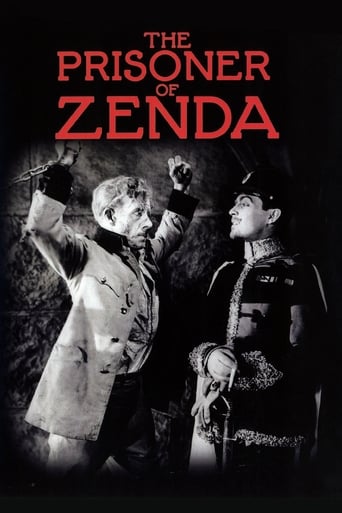JohnHowardReid
Copyright 29 July 1922 by Metro Pictures Corporation. New York opening at the Astor: 31 July 1922. U.S. release: 11 September 1922. 10 reels. 10,467 feet. 116 minutes. COMMENT: Selected by The New York Times as one of the best films of the year, the familiar story (re-made with Ronald Colman in 1937 and Stewart Granger in 1952) is given grand treatment here.Some critics have complained of this version's lack of action. While it's true that Ingram does tend to concentrate more on the romance between Lewis Stone's reluctant Rassendyll and the beautiful princess (charmingly enacted by Alice Terry) and also on a closer examination of Black Michael's political intriguing than do the various remakes, there is nonetheless a fair amount of action-and it is well handled too, particularly the final sword duels between hero and villains with all the players including Stone, Holmes and Novarro doing their own fencing and doing it very ably indeed.
In addition to these excitements, as might be expected, cinema stylist Rex Ingram has a grand time with all the sets, costumes and panoply of Zenda. It's amazing how close the remakes follow not only the plot and the various incidents, but even the incidentals like the opening knockabout at the railway station.
Ramon Novarro's fans will be a little disappointed to find their hero playing the villain (especially as he is not quite as charming as in other versions), but everyone cheers when the beautiful Barbara La Marr enters. AVAILABLE on DVD through Grapevine. Quality rating varies from 5 to 7 out of ten, but almost all is quite watchable
Ian
(Flash Review)This story was so intriguing that there were 4 or 5 remakes and/or adaptations based on this 1922 original. There is a prince who will be coronated king the following day. Some other royals hatch a plan to kidnap him, thus allowing one of them to be crowned king. Once the king goes missing, some of his allies spot a lookalike and decide to have him pose in place of the future king. He has to convince the future king's lovely lady as well as his friends that he is the real guy. The story sets up for some fun obstacles and to see how things play out. The film does a good job of organizing several characters, has some nice castle shots yet the pacing could have shifted up a couple gears.
wes-connors
English traveler and sportsman Lewis Stone (as Rudolf Rassendyll) decides to attend the coronation of distant relative "Rudolf V." of Ruritania (also Lewis Stone, in a dual role), after the recent death of the foreign land's King. But proposed King Stone has a wicked half-brother, who covets the title. Receiving most of his help from charismatic Ramon Novarro (as Rupert of Hentzau), treacherous brother Stuart Holmes (as Grand Duke Michael) plots to poison Mr. Stone and take his place on the throne. But, due to the royal Rudolf's fondness for alcohol, a switch is made. One who senses something rotten in Ruritania is beautiful Alice Terry (as Princess Flavia), who is expected to marry one, but falls in love with another..."Towards the end of the day, when the soul is weary and the heart longs for its beloved"...Anthony Hope's classic adventure story gets the MGM treatment, even though the studio mostly called "Metro" by insiders was only M-G- (no Mayer, yet) at the time. Metro's mega-hit "The Four Horsemen of the Apocalypse" (1921) director Rex Ingram and the principle players gathered here stuck with the company; helping set the standard for MGM productions, Metro/MGM competed successfully with older studios. This film advanced careers, most notably helping propel Mr. Novarro to "superstar" status. There are also fine impressions made by veteran Robert Edeson (as Colonel Sapt), bewitching Barbara La Marr (as Antoinette de Mauban) and debuting Malcolm McGregor (as Fritz von Tarlenheim)...Notable re-makes in 1937 (all talking, with Ronald Colman) and 1952 (in color, with Stewart Granger) are worth seeking out in a "twofer" package from Warner/Turner. They should have added this 1922 version. It's still entertaining, due to swaggering action, good production values and captivating performances. This non-speaking "The Prisoner of Zenda" was the standard silent film era version. It was the #4 "Best Picture" of 1922 according to the annual "Film Daily" poll of critics. Rex Ingram, Lewis Stone, Alice Terry and Ramon Novarro received director and acting accolades. Stone, at his silent best here, essays a small part in the 1952 version; it was one of the last roles for the perennial Metro-contracted actor.******** The Prisoner of Zenda (7/31/22) Rex Ingram ~ Lewis Stone, Alice Terry, Ramon Novarro, Malcolm McGregor
David Atfield
Rex Ingram was one of the great visual stylists of the silent cinema, but his version of "The Prisoner of Zenda" is a little slow and ponderous and visually not as interesting as other Ingram films. But it's still pretty good with strong performances from Ingram's wife Alice Terry and the marvellous Lewis Stone. Although Ramon Novarro has top billing, Stone actually has the lead role - Ramon's role is a supporting one - an evil nobleman. But he is splendid - darkly handsome with a little beard and a monocle - and convincingly evil. It is interesting to see him before he became type-cast as the energetic sweet boy - he shows here that he had more range as an actor than he was allowed to show.The entire supporting cast is excellent and, although the sets are ordinary, the costumes are very fine. I expected more from Ingram, but this film is still worthwhile. Does anyone know if the Ingram - Novarro "Scaramouche" is still in existence?


